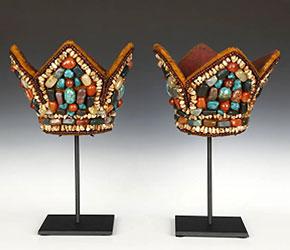| |
 |
| |
Ladakh pair of ceremonial arm cuffs |
Ladakh, today a part of Northern
India, is the largest
Tibetan
refugee area in the world. This is because Ladakh continued to look to Tibet for religious inspiration despite being politically demarcated from Tibet since 1942. Essentially, “Tibetan Buddhism” is practiced in Ladakh by both the refugees and Ladakhis. Although austere philosophically, Tibetan Buddhism does support many rituals attendant to its spiritual practice. One striking part of Ladakhi traditional life is the wearing of heavily ornamented costumes covered with turquoise, carnelian, mother-of-pearl, coral, and other semi-precious materials. The most well known adornment is called the perak; it is a dearly cherished heirloom among the Ladakhi people and may (technically) be the largest piece of jewelry worn in the world.
 |
|
| Ladakh breastplate |
|
Various types of headdresses are used throughout Ladakh; most are typically put together from pieces of dark fabric or leather, on which long rows of turquoise are stitched. The turquoise stones, trade items formerly gotten from sources in
China, Tibet, and the Khotan area of Central Asia, are now obtained from markets in India. Rows of turquoise are often enhanced by a prominent gau, an amulet box sewed onto the center of the headdress. The outfit is further beautified by adding separate segments of decorated cloth. The perak is fastened onto a hairpiece made out of woolen braids, and the whole headdress is held in place on the owner’s head by silver chains and stiff ear-flaps.
The perak traditionally signified the wealth of the mother, which was passed along to her daughter when she married and left home to live with her husband. In central Ladakh, a traditional bride was outfitted in white bangles, amber jewelry, conch shells, a brocaded cape, embroidered shoes, silver thigh ornaments, and the headdress draped over her body. During the earlier period of the monarchy, the queens in Leh, the capital of
Ladakh
, wore headdresses with nine rows of turquoise beads, while today a woman with seven rows in Leh has a lot of status. In the smaller towns, headdresses with five rows are marvels, and lower ranking women often have three-row peraks.
In the traditional Ladakhi belief system, jewels propitiated the deities symbolically, and they provided abstract representations of the
Buddha
. The headdresses thus had important symbolic and ritual significance. The perak, according to scholars, identifies the woman’s body with the lu, the subterranean, serpentine deities that protect the human world. Since the headdresses channel divine protection to humanity, their owners had to wear them at public and ceremonial functions, particularly when they visited festivals or monasteries.
The current generation of mothers and grandmothers are probably the last custodians of in-depth cultural knowledge about
Ladakh
’s costume traditions. Traditions are slowly fading and with the passing on of the elders, the cultural knowledge held collectively by this aging group will be lost to the world.
Download this Article: Ladakh Ceremonial Attire.pdf

